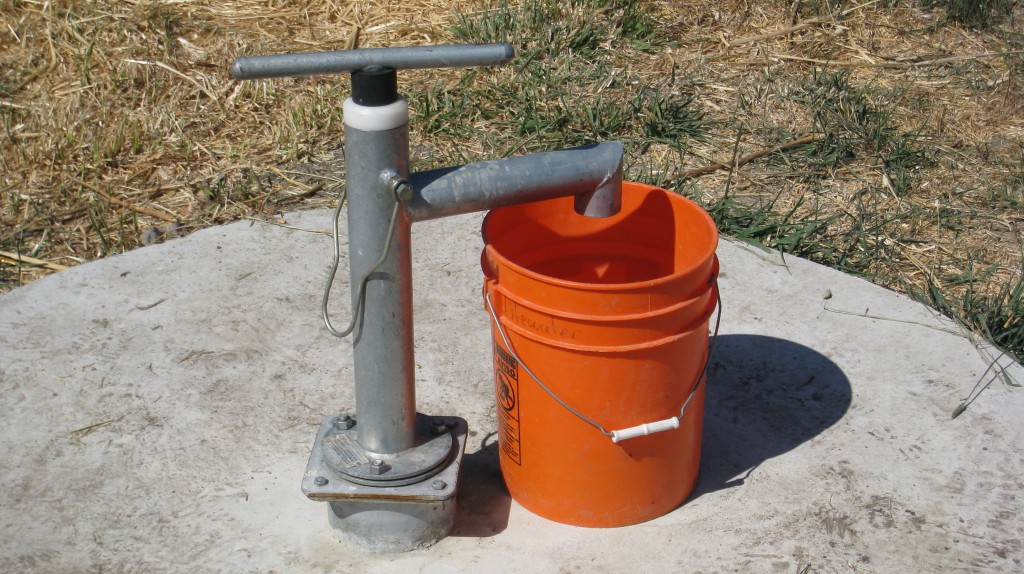Difference between revisions of "Direct action handpump"
| Line 4: | Line 4: | ||
Direct action handpumps are usually made of PVC and other plastics, and are installed on boreholes of limited depth. A plunger is attached to the lower end of a pump rod, beneath the groundwater level. The user moves the pump rod in an up-and-down motion, using a T-bar handle. On the up-stroke, the plunger lifts water into the rising main, and replacement water is drawn into the cylinder through the foot valve. On the downstroke, the foot valve closes, and water passes through a one-way valve in the plunger and is lifted on the next up-stroke. Because direct action handpumps have no mechanical advantage, such as the lever or fly-wheel of a deep-well handpump, direct action pumps can only be used to depths from which an individual can physically lift the column of water (about 12 m). However, the mechanical simplicity, low cost and lightweight construction makes these pumps well equipped to meet O&M objectives at the village level. | Direct action handpumps are usually made of PVC and other plastics, and are installed on boreholes of limited depth. A plunger is attached to the lower end of a pump rod, beneath the groundwater level. The user moves the pump rod in an up-and-down motion, using a T-bar handle. On the up-stroke, the plunger lifts water into the rising main, and replacement water is drawn into the cylinder through the foot valve. On the downstroke, the foot valve closes, and water passes through a one-way valve in the plunger and is lifted on the next up-stroke. Because direct action handpumps have no mechanical advantage, such as the lever or fly-wheel of a deep-well handpump, direct action pumps can only be used to depths from which an individual can physically lift the column of water (about 12 m). However, the mechanical simplicity, low cost and lightweight construction makes these pumps well equipped to meet O&M objectives at the village level. | ||
| − | '''Trademarks:''' Blair; Ethiopia BP50; Malawi Mark V; Nira | + | '''Trademarks:''' Blair; Ethiopia BP50; Malawi Mark V; Wavin. |
| + | |||
| + | '''Public Domain:''' [http://www.rural-water-supply.net/en/implementation/handpump-overview/nira-af-85-pump Nira AF-85], [http://www.rural-water-supply.net/en/implementation/handpump-overview/tara-pump Tara Pump], [http://www.rural-water-supply.net/en/implementation/handpump-overview/malda-pump Malda] | ||
==Suitable conditions== | ==Suitable conditions== | ||
Revision as of 16:24, 15 October 2012
Direct action handpumps are usually made of PVC and other plastics, and are installed on boreholes of limited depth. A plunger is attached to the lower end of a pump rod, beneath the groundwater level. The user moves the pump rod in an up-and-down motion, using a T-bar handle. On the up-stroke, the plunger lifts water into the rising main, and replacement water is drawn into the cylinder through the foot valve. On the downstroke, the foot valve closes, and water passes through a one-way valve in the plunger and is lifted on the next up-stroke. Because direct action handpumps have no mechanical advantage, such as the lever or fly-wheel of a deep-well handpump, direct action pumps can only be used to depths from which an individual can physically lift the column of water (about 12 m). However, the mechanical simplicity, low cost and lightweight construction makes these pumps well equipped to meet O&M objectives at the village level.
Trademarks: Blair; Ethiopia BP50; Malawi Mark V; Wavin.
Public Domain: Nira AF-85, Tara Pump, Malda
Contents
Suitable conditions
Range of depth: 0–12 m.
Yield: 0.25–0.42 litres/s at 12 m depth.
Area of use: Rural and low-income periurban areas, where groundwater tables are within 12 m of the surface.
Construction, operations and maintenance
The pump is operated by moving a handle up and down. As the plunger is located underwater, no priming is needed. Adults, and even children, can pump the water, although if the water table is below 5 m, this may be difficult for children. The pump stand and site must be kept clean.
Maintenance of direct action pumps is relatively simple and can be taught to users or caretakers, sometimes within a few hours. For preventive maintenance, usually only one or two people are needed. Daily activities consist of checking the pump performance and the appearance of the water (if it is cloudy with silt, the borehole must be cleaned).
Annually, the pump should be taken apart and checked. Small repairs include replacing worn cupseals and washers, straightening bent pump rods, and replacing corroded lock nuts. To carry out major repairs (e.g. a broken pump rod or rising main, cracks in the welding of metal parts), skilled help may be needed. O&M can be organized at community level, and since maintenance is relatively simple, good organization will result in a reliable service.
Potential problems
— worn washers, plungers and foot valve parts;
— abrasion of the seal on the PVC cylinder and between the pump rod and rising main;
— broken or damaged handles;
— the maximum lift is limited to about 12 m;
— the force needed to pump the water may be too great for children, especially if the water table is below 5 m.
Costs
From about US$ 100 to over $ 900 (1985 prices). Models suitable for village level O&M cost less than US$ 150.
Acknowledgements
- Brikke, François, and Bredero, Maarten. Linking technology choice with operation and maintenance in the context of community water supply and sanitation: A reference document for planners and project staff. World Health Organization and IRC Water and Sanitation Centre. Geneva, Switzerland 2003.

